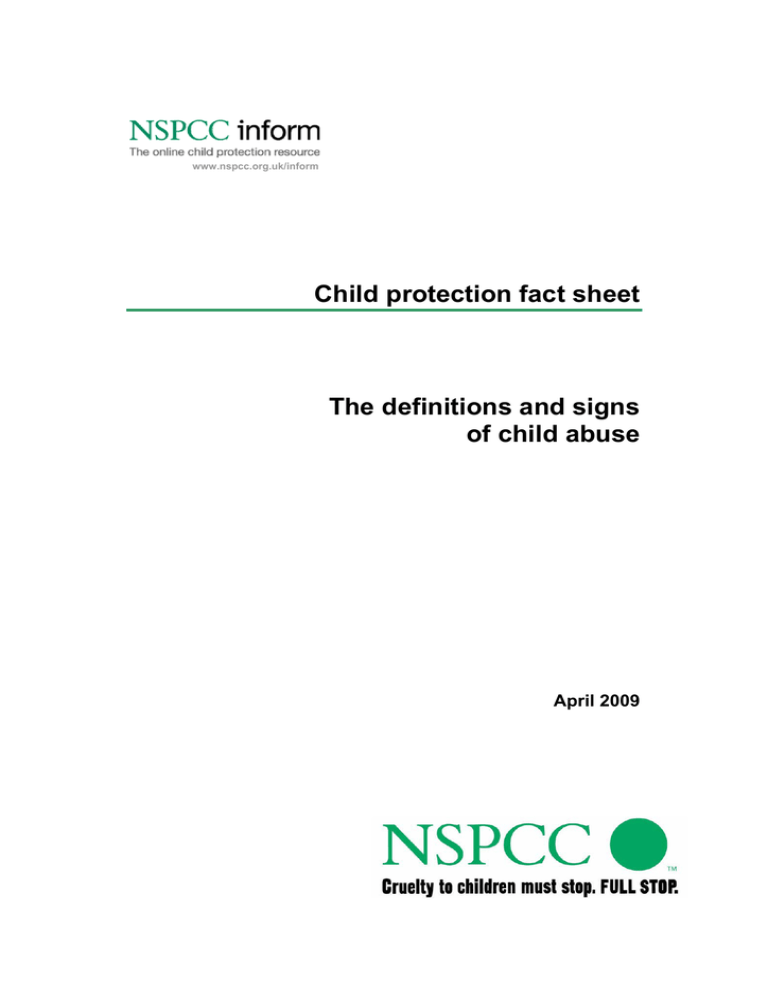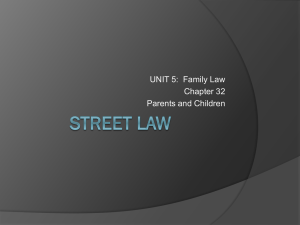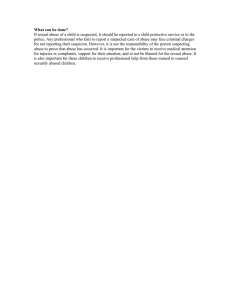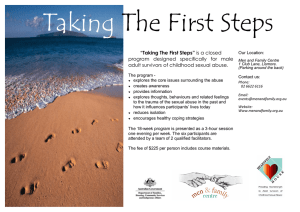
www.nspcc.org.uk/inform
Child protection fact sheet
The definitions and signs
of child abuse
April 2009
Child protection fact sheet
Definitions and signs of child abuse
This fact sheet has been compiled by NSPCC Consultancy Services.
It provides
guidance for people working in voluntary, community and commercial organisations
that have child protection policies in place, on how they can recognise the signs of child
abuse, so that they can alert the appropriate authorities. This does not constitute legal
advice.
Abuse and neglect are forms of maltreatment of a child. Somebody may abuse or neglect a
child either directly by inflicting harm, or indirectly, by failing to act to prevent harm.
Children may be abused in a family or in an institutional or community setting; by those
known to them; or, more rarely, by a stranger. They may be abused by an adult or adults, or
another child or children.
Definitions
There are five types of child abuse. They are defined in the UK Government guidance
Working Together to Safeguard Children (2006) as follows:
Physical abuse
Physical abuse may involve hitting, shaking, throwing, poisoning, burning or scalding,
drowning, suffocating, or otherwise causing physical harm to a child or failing to protect a
child from that harm. Physical harm may also be caused when a parent or carer fabricates the
symptoms of, or deliberately induces illness in a child.
Emotional Abuse
Emotional abuse is the persistent emotional maltreatment of a child such as to cause severe
and persistent adverse effects on the child’s emotional development. It may involve
conveying to children that they are worthless or unloved, inadequate, or valued only insofar as
they meet the needs of another person.
It may feature age- or developmentally inappropriate expectations being imposed on children.
These may include interactions that are beyond the child’s developmental capability, as well
as overprotection and limitation of exploration and learning, or preventing the child
participating in normal social interaction. It may involve seeing or hearing the ill-treatment of
© NSPCC 2009
1
Child protection fact sheet
Definitions and signs of child abuse
another. It may involve serious bullying causing children frequently to feel frightened or in
danger, or the exploitation or corruption of children. Some level of emotional abuse is
involved in all types of maltreatment of a child, though it may occur alone.
Sexual Abuse
Sexual abuse involves forcing or enticing a child or young person to take part in sexual
activities, including prostitution, whether or not the child is aware of what is happening. The
activities may involve physical contact including both penetrative or non-penetrative acts
such as kissing, touching or fondling the child's genitals or breasts, vaginal or anal intercourse
or oral sex .
They may include non-contact activities, such as involving children in looking at, or in the
production of, pornographic material or watching sexual activities, or encouraging children to
behave in sexually inappropriate ways.
Neglect
Neglect is the persistent failure to meet a child’s basic physical and/or psychological needs,
likely to result in the serious impairment of the child’s health or development. Neglect may
occur during pregnancy as a result of maternal substance abuse. Once a child is born, neglect
may involve a parent or carer failing to provide adequate food and clothing; shelter, including
exclusion from home or abandonment; failing to protect a child from physical and emotional
harm or danger; failure to ensure adequate supervision including the use of inadequate caretakers; or the failure to ensure access to appropriate medical care or treatment. It may also
include neglect of, or unresponsiveness to, a child’s basic emotional needs.
Bullying
Bullying may be defined as deliberately hurtful behaviour, usually repeated over a period of
time, where it is difficult for those bullied to defend themselves. It can take many forms, but
the three main types are physical (e.g. hitting, kicking, theft), verbal (e.g. racist or
homophobic remarks, threats, name calling) and emotional (e.g. isolating an individual from
the activities and social acceptance of their peer group).
© NSPCC 2009
2
Child protection fact sheet
Definitions and signs of child abuse
The damage inflicted by bullying can frequently be underestimated. It can cause considerable
distress to children to the extent that it affects their health and development or, at the extreme,
cause them significant harm (including self-harm). All settings in which children are provided
with services or are living away from home should have in place rigorously enforced antibullying strategies.
Signs of abuse
Recognising child abuse is not easy. It is not your responsibility to decide whether or not
child abuse has taken place or if a child is at significant risk of harm from someone. You do
however, have both a responsibility and duty, as set out in your organisation’s child protection
procedures, to act in order that the appropriate agencies can investigate and take any
necessary action to protect a child.
The following information should help you to be more alert to the signs of possible abuse.
Physical Abuse
Most children will collect cuts and bruises as part of the rough-and-tumble of daily life.
Injuries should always be interpreted in light of the child’s medical and social history,
developmental stage and the explanation given. Most accidental bruises are seen over bony
parts of the body, e.g. elbows, knees, shins, and are often on the front of the body. Some
children, however, will have bruising that is more than likely inflicted rather than accidental.
Important indicators of physical abuse are bruises or injuries that are either unexplained or
inconsistent with the explanation given, or visible on the ‘soft’ parts of the body where
accidental injuries are unlikely, e g, cheeks, abdomen, back and buttocks. A delay in seeking
medical treatment when it is obviously necessary is also a cause for concern, although this can
be more complicated with burns, as these are often delayed in presentation due to blistering
taking place some time later.
The physical signs of abuse may include:
unexplained bruising, marks or injuries on any part of the body
multiple bruises- in clusters, often on the upper arm, outside of the thigh
cigarette burns
© NSPCC 2009
3
Child protection fact sheet
human bite marks
broken bones
scalds, with upward splash marks,
multiple burns with a clearly demarcated edge.
Definitions and signs of child abuse
Changes in behaviour that can also indicate physical abuse:
fear of parents being approached for an explanation
aggressive behaviour or severe temper outbursts
flinching when approached or touched
reluctance to get changed, for example in hot weather
depression
withdrawn behaviour
running away from home.
Emotional Abuse
Emotional abuse can be difficult to measure, as there are often no outward physical signs.
There may be a developmental delay due to a failure to thrive and grow, although this will
usually only be evident if the child puts on weight in other circumstances, for example when
hospitalised or away from their parents’ care. Even so, children who appear well-cared for
may nevertheless be emotionally abused by being taunted, put down or belittled. They may
receive little or no love, affection or attention from their parents or carers. Emotional abuse
can also take the form of children not being allowed to mix or play with other children.
Changes in behaviour which can indicate emotional abuse include:
neurotic behaviour e.g. sulking, hair twisting, rocking
being unable to play
fear of making mistakes
sudden speech disorders
self-harm
fear of parent being approached regarding their behaviour
developmental delay in terms of emotional progress
© NSPCC 2009
4
Child protection fact sheet
Definitions and signs of child abuse
Sexual Abuse
Adults who use children to meet their own sexual needs abuse both girls and boys of all ages,
including infants and toddlers. Usually, in cases of sexual abuse it is the child’s behaviour
that may cause you to become concerned, although physical signs can also be present. In all
cases, children who tell about sexual abuse do so because they want it to stop. It is important,
therefore, that they are listened to and taken seriously.
The physical signs of sexual abuse may include:
pain or itching in the genital area
bruising or bleeding near genital area
sexually transmitted disease
vaginal discharge or infection
stomach pains
discomfort when walking or sitting down
pregnancy
Changes in behaviour which can also indicate sexual abuse include:
sudden or unexplained changes in behaviour e.g. becoming aggressive or withdrawn
fear of being left with a specific person or group of people
having nightmares
running away from home
sexual knowledge which is beyond their age, or developmental level
sexual drawings or language
bedwetting
eating problems such as overeating or anorexia
self-harm or mutilation, sometimes leading to suicide attempts
saying they have secrets they cannot tell anyone about
substance or drug abuse
suddenly having unexplained sources of money
not allowed to have friends (particularly in adolescence)
acting in a sexually explicit way towards adults
© NSPCC 2009
5
Child protection fact sheet
Definitions and signs of child abuse
Neglect
Neglect can be a difficult form of abuse to recognise, yet have some of the most lasting and
damaging effects on children.
The physical signs of neglect may include:
constant hunger, sometimes stealing food from other children
constantly dirty or ‘smelly’
loss of weight, or being constantly underweight
inappropriate clothing for the conditions.
Changes in behaviour which can also indicate neglect may include:
complaining of being tired all the time
not requesting medical assistance and/or failing to attend appointments
having few friends
mentioning being left alone or unsupervised.
Bullying
Bullying is not always easy to recognise as it can take a number of forms. A child may
encounter bullying attacks that are:
physical: pushing, kicking, hitting, pinching and other forms of violence or threats
verbal: name-calling, sarcasm, spreading rumours, persistent teasing
emotional: excluding (sending to Coventry), tormenting, ridiculing, humiliating.
Persistent bullying can result in:
depression
low self-esteem
shyness
poor academic achievement
isolation
threatened or attempted suicide
© NSPCC 2009
6
Child protection fact sheet
Definitions and signs of child abuse
Signs that a child may be being bullied can be:
coming home with cuts and bruises
torn clothes
asking for stolen possessions to be replaced
losing dinner money
falling out with previously good friends
being moody and bad tempered
wanting to avoid leaving their home
aggression with younger brothers and sisters
doing less well at school
sleep problems
anxiety
becoming quiet and withdrawn
These definitions and indicators are not meant to be definitive, but only serve as a guide to
assist you. It is important too, to remember that many children may exhibit some of these
indicators at some time, and that the presence of one or more should not be taken as proof that
abuse is occurring. There may well be other reasons for changes in behaviour such as a death
or the birth of a new baby in the family or relationship problems between parents/carers. In
assessing whether indicators are related to abuse or not, the authorities will always want to
understand them in relation to the child’s development and context.
© NSPCC 2009
7
Weston House
42 Curtain Road
London EC2A 3NH
Tel: 020 7825 2500
www.nspcc.org.uk/inform
The National Society for the Prevention of
Cruelty to Children (NSPCC) has a vision –
a society where all children are loved, valued
and able to fulfil their potential.
Our mission is to end cruelty to children.
The NSPCC is the UK’s leading charity
specialising in child protection and the
prevention of cruelty to children. For over
100 years it has been protecting children
from cruelty and is the only children’s charity
with statutory powers, enabling it to act to
safeguard children at risk.
© NSPCC 2009
All rights reserved. No part of this publication may be reproduced,
stored in a retrieval system or transmitted by any means,
electronic, mechanical, photocopying or otherwise without the prior
written permission of the copyright holder.
First published 2009 by the NSPCC.
Registered charity numbers 216401 and SC037717





